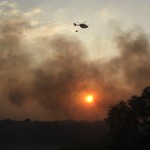After the Labor Day Fires, Reuniting Pets With Their Owners

Photo by Matt Largey/KUT News
2011 wildfire evacuations sometimes happened too fast for residents to collect their or their neighbors' pets.
Nathan Bernier of KUT News reported this article as part of our special series on the 2011 Labor Day Wildfires with KUT News, Forged in Flames.
Today at 3 p.m., KUT 90.5 FM in Austin will air a special one-hour documentary telling the story of the fires. It will air again Wednesday, Sept. 5 at 7 p.m. You can listen on air and online, and download the documentary here at StateImpact Texas.
Exactly one year ago today, large wildfires broke out in Bastrop, Steiner Ranch, Spicewood, Pflugerville and other communities in Central Texas. Hundreds of people were forced from their homes and grabbed whatever they could in the few minutes they had. But that often meant that pets were left behind to fend for themselves.
As the fires rapidly approached, families were told they had to evacuate. Residents like Michelle Bielinkski from Steiner Ranch recalls getting her entire family into their car, then hearing noises from her neighbor’s home.
“Because they were out of town but we had know the dogs were there because we could hear them barking,” she remembers. “That’s when the policeman stopped us from going back over to their house. Because at that point we were going to break the window to see if we can get them out.”But Bielinski wasn’t allowed to. So she asked a firefighter if he could rescue the dogs.
“And he said that there weren’t enough fire personnel for people, so we just all did what we could,” she says.
The dogs didn’t survive.
But many other animals did make it. Some were fed and watered by first responders in the evacuation zone.
In Bastrop, pets were piling up at the animal shelter. The situation was so dire that animal protection groups in neighboring cities offered to help take in some of the animals to relieve the burden. The Austin Humane Society was one of those groups. Chief veterinarian Katie Luke was working that day, when injured and abandoned animals started pouring in.
“I guess chaotic is the best way to say it,” Luke recalls. “Because a truck would arrive and the energy level went up, and we were excited to be able to help, and we would just triage and get them all situated. Then the next truck would come. It was just kind of a constant flow of animals.”
Dr. Luke says as the day went on, animals arrived with more serious injuries.
“Third degree burns to the feet, so their foot pads were completely burned through and gone,” Luke remembers. “That was something I’ve never seen before. So that was a little heart breaking. We obviously had to figure out how to take care of these cats the best way. Most of them were kitties.”
Eventually owners started coming looking for their pets. But Austin Humane Society staff encountered one major obstacle when trying to reunite them.
“Most of the kitties we saw, especially the longer haired kitties, their coats were singed so much that when we first saw these cats, the first few we saw, we thought maybe they had been shaven recently,” Luke says. “It really looked like they had been groomed down to their skin. They still had a very short hair coat, but none of the long haired cats came out with long hair.”
Workers used photographs to try to match hair color patterns with the injured pets. Only a few of the cats were implanted with microchips, which were all reunited with their owners.
Amazingly, only a couple animals were so badly injured they had to be euthanized. The rest recovered, although in some cases it took weeks. Every single one ultimately found a home.
“It’s completely changed how we prepare,” Katie Luke of the Austin Humane Society says. “I think before the Bastrop fires we were thinking more of the Humane Society as a place to provide that evacuation sheltering, and we stepped into a role that we haven’t been in before, providng this intensive care, emergency care, and we saw that we could do it and do it well. It’s completely made us even more dedicated to emergency response, but also elevated the level that we expect from ourselves.”
